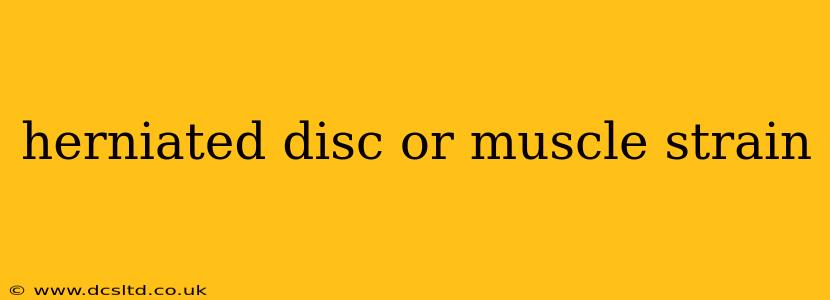Back pain is a common ailment, often leaving sufferers wondering about the underlying cause. Two frequent culprits are herniated discs and muscle strains. While both can cause significant discomfort, understanding their differences is crucial for proper diagnosis and treatment. This article will delve into the specifics of each condition, helping you differentiate between them and understand how to seek appropriate medical attention.
What is a Herniated Disc?
A herniated disc, also known as a slipped or ruptured disc, occurs when the soft, gel-like center of an intervertebral disc pushes through a tear in the tougher outer layer. These discs act as cushions between the vertebrae in your spine. A herniation can put pressure on nearby nerves, leading to pain, numbness, tingling, or weakness radiating down the arm or leg (depending on the location of the herniation). The pain is often sharp and intense, and may worsen with certain movements.
What is a Muscle Strain?
A muscle strain, or pulled muscle, involves an overstretching or tearing of muscle fibers. This typically occurs due to sudden movements, overuse, or poor posture. Muscle strains in the back often result in localized pain and stiffness, which can be aggravated by movement. Unlike a herniated disc, the pain associated with a muscle strain is usually less intense and doesn't typically radiate down the limbs.
What are the Symptoms of a Herniated Disc?
Pain Radiating Down the Leg or Arm: This is a hallmark symptom of a herniated disc. The pain isn't confined to the back; it travels down the limb, often following a specific nerve pathway.
Numbness and Tingling: Pressure on the nerves from a herniated disc can cause numbness, tingling, or a pins-and-needles sensation in the affected limb.
Weakness: Muscle weakness in the affected limb is another potential symptom, resulting from nerve compression.
Sharp, Intense Pain: The pain associated with a herniated disc is often described as sharp, shooting, or electric-like.
Limited Range of Motion: Difficulty bending, twisting, or lifting can indicate a herniated disc.
What are the Symptoms of a Muscle Strain?
Localized Pain and Stiffness: Pain is usually concentrated in the affected muscle and surrounding area.
Muscle Spasms: Involuntary muscle contractions can occur, leading to further pain and stiffness.
Swelling: Some swelling may be present at the site of the strain.
Tenderness to the Touch: The affected muscle will likely be tender when touched.
Pain with Movement: Pain worsens with specific movements that engage the strained muscle.
How are Herniated Discs and Muscle Strains Diagnosed?
Diagnosis typically involves a physical examination and medical history review. Imaging studies like X-rays, MRIs, or CT scans may be used to confirm the diagnosis and rule out other conditions. An MRI is particularly useful for visualizing herniated discs.
How are Herniated Discs and Muscle Strains Treated?
Treatment for both conditions varies depending on severity. Conservative treatments, such as rest, ice/heat therapy, over-the-counter pain relievers (like ibuprofen or naproxen), physical therapy, and exercise, are often the first line of defense. For severe cases, more aggressive interventions, including surgery for herniated discs or injections for pain relief, might be considered.
Can a Muscle Strain Mimic a Herniated Disc?
Yes, the symptoms of a severe muscle strain can sometimes overlap with those of a herniated disc, making diagnosis challenging. This is why a thorough medical evaluation is essential.
What is the Difference Between a Herniated Disc and Sciatica?
Sciatica refers to pain that radiates along the sciatic nerve, which runs from the lower back down the leg. A herniated disc is a common cause of sciatica, but other conditions can also cause it. Therefore, sciatica is a symptom rather than a diagnosis itself.
How Long Does it Take to Recover from a Herniated Disc or Muscle Strain?
Recovery time varies greatly depending on the severity of the condition and individual factors. Muscle strains often heal within a few weeks, while herniated discs may take several months or longer to fully recover.
When Should I See a Doctor?
Seek immediate medical attention if you experience sudden, severe back pain, especially if accompanied by numbness, tingling, weakness, or bowel/bladder dysfunction. If your back pain is persistent, worsens over time, or interferes with your daily activities, consult a doctor for proper diagnosis and treatment. Early intervention can significantly impact recovery and prevent long-term complications.
